How much sugar in grapes you need to know in order to understand which grade for which purpose is better to use - for drying, preparing drinks. Winemakers need these indicators to determine the taste characteristics of wine in order to determine which raw materials are best to choose for their products. It is important to understand that it is worth considering not only sweetness, but also acidity, as well as their ratio. All these figures will say little to the average layman, but manufacturers without them will not be able to create truly mesmerizing tastes of drinks.
Content
Understanding concepts
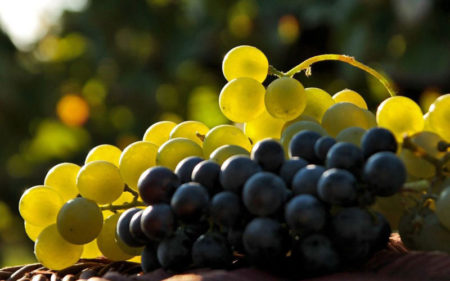 There are indicators of “sugar content” or “sugar accumulation”, which are very important in determining the quality of raw materials for further processing. Their content consists of glucose and fructose, although by the beginning of the harvest, other substances also accumulate in the berries - galactose, ribose, maltose, raffinose, xylose, etc. On average, the numbers fluctuate between 13-28%, only some varieties reach overripe 40% Depending on the level of sugar content, the quality of the crop and the further industry of use are determined.
There are indicators of “sugar content” or “sugar accumulation”, which are very important in determining the quality of raw materials for further processing. Their content consists of glucose and fructose, although by the beginning of the harvest, other substances also accumulate in the berries - galactose, ribose, maltose, raffinose, xylose, etc. On average, the numbers fluctuate between 13-28%, only some varieties reach overripe 40% Depending on the level of sugar content, the quality of the crop and the further industry of use are determined.
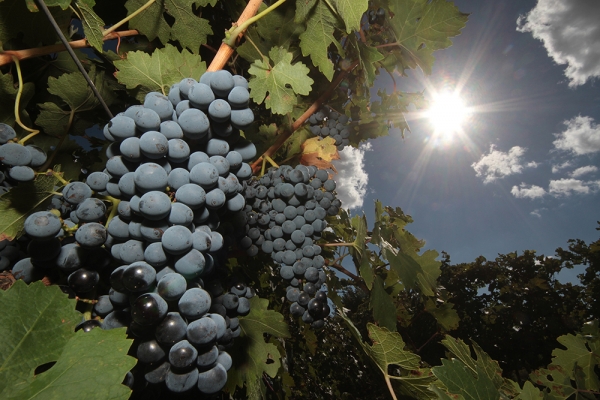
The best muscat grapes: description and photo
Muscat grapes occupy a special place among grape varieties; they are an aristocracy in the world of wine making. Most likely ...
When describing the variety, the average concentration of sugars is taken into account, but in fact it can vary depending on ripening conditions, soils, rainfall and sunny days. The main sweetness of the berries is gained in the last days before the harvest. For table wines, berries are picked at the time of full ripening, for champagne they start a little earlier, and to get dessert drinks a little later, allowing the grapes to ripen.
What does sugar content depend on?
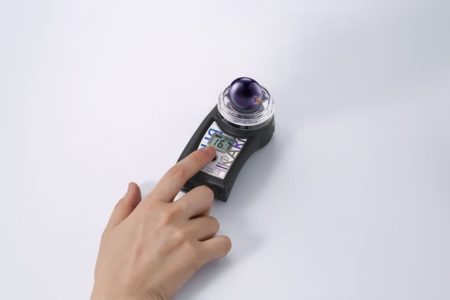 This indicator depends on the variety and its characteristics. It is also important to take into account several other factors that together affect the taste and sugar content:
This indicator depends on the variety and its characteristics. It is also important to take into account several other factors that together affect the taste and sugar content:
- soil type (acidity, moisture, density, mineral composition);
- geographical location (climate, rainfall, altitude);
- level of insolation (indicator of solar radiation);
- the proximity of water bodies;
- level of agricultural technology.
Growing region
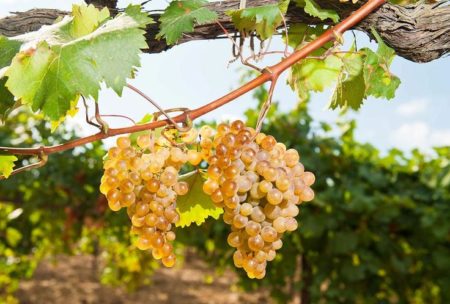 The higher the average annual temperature and the number of sunny days in the growing area, the higher the level of sugar accumulation in the fruits. The Asian, Central Asian and coastal regions are excellent in climate, because here the weather is warm, which contributes to better ripening and higher sugar content in grapes. On average, varieties grown here have about 30-32%. It is also worth noting that the mountainous area favors taste and sweetness. Mountains protect from strong winds and heavy rainfall, which also helps to maintain high taste properties of the crop.
The higher the average annual temperature and the number of sunny days in the growing area, the higher the level of sugar accumulation in the fruits. The Asian, Central Asian and coastal regions are excellent in climate, because here the weather is warm, which contributes to better ripening and higher sugar content in grapes. On average, varieties grown here have about 30-32%. It is also worth noting that the mountainous area favors taste and sweetness. Mountains protect from strong winds and heavy rainfall, which also helps to maintain high taste properties of the crop.
Soil composition
Grapes can grow on any soil, but the taste, sugar content, brush sizes will vary greatly even within the same variety. Therefore, it is worth considering some features that will help to grow a sweeter crop. It is better not to plant wine varieties on chernozem, because of the high nitrogen content in the soil, the stems will be powerful, and the formation of vines will be weak.Mixed soils are best suited - sandy, sandy loam, loamy, clayey with the content of silt, stones, organic substances. The main thing is that the earth conducts water well, and it does not stagnate.
Water availability
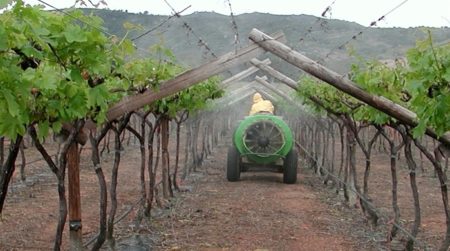 To grow a good harvest with pronounced sugar content, it is necessary to take into account the features of this culture when watering. Optimal conditions - periodic watering at the time of growth of stems and leaves, the absence of clusters during ripening before harvesting. It is important to maintain a balance in which the plants receive a sufficient amount of moisture, but are not exposed to drought or stagnation of water in the soil. With excess moisture, the berries grow watery, without a pronounced bouquet of taste, with a lack of berries become sweet, but remain small. If the groundwater level lies no deeper than 6 m, and the annual rainfall is not less than 400 mm, then the vineyards can do without additional irrigation. In more arid climates or too deep underground sources, an additional irrigation system will have to be built. On average, the soil moisture level should be maintained at around 70-75%, then the sweetness indicators will please.
To grow a good harvest with pronounced sugar content, it is necessary to take into account the features of this culture when watering. Optimal conditions - periodic watering at the time of growth of stems and leaves, the absence of clusters during ripening before harvesting. It is important to maintain a balance in which the plants receive a sufficient amount of moisture, but are not exposed to drought or stagnation of water in the soil. With excess moisture, the berries grow watery, without a pronounced bouquet of taste, with a lack of berries become sweet, but remain small. If the groundwater level lies no deeper than 6 m, and the annual rainfall is not less than 400 mm, then the vineyards can do without additional irrigation. In more arid climates or too deep underground sources, an additional irrigation system will have to be built. On average, the soil moisture level should be maintained at around 70-75%, then the sweetness indicators will please.
Determination of sugar content
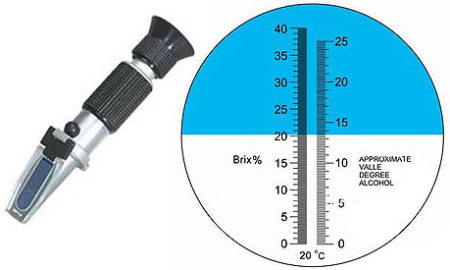 The level of sugar content is determined using additional devices - a hydrometer or refractometer. Combined samples will require about 3 kg. grapes or 1 kg. pulp to conduct chemical analysis by direct volumetric titration. In order for the analyzes to be averaged throughout the vineyard, it is necessary to collect berries from different bushes, adding those that grow below, above, in the middle of the bush. If samples are taken in the vineyard, a field refractometer is selected. Measurements are carried out three times within 15 days before the start of collection, once every 5 days. From the moment of technical maturity, samples are taken daily. In order to have objective indicators of average sugar content, at least 10 samples should be performed on each site.
The level of sugar content is determined using additional devices - a hydrometer or refractometer. Combined samples will require about 3 kg. grapes or 1 kg. pulp to conduct chemical analysis by direct volumetric titration. In order for the analyzes to be averaged throughout the vineyard, it is necessary to collect berries from different bushes, adding those that grow below, above, in the middle of the bush. If samples are taken in the vineyard, a field refractometer is selected. Measurements are carried out three times within 15 days before the start of collection, once every 5 days. From the moment of technical maturity, samples are taken daily. In order to have objective indicators of average sugar content, at least 10 samples should be performed on each site.
Types of sugary substances
There are 3 main types of sugary substances - glucose, fructose and sucrose. Moreover, according to the characteristics, glucose is the least sweet of all, slightly sweeter (1.45 times) is sucrose, the sweetest (level 2.2 times higher than in glucose) is fructose. The ratio of these substances in the fruit changes as it ripens. Sucrose is gradually formed in the green leaves and stems, then at the beginning of the formation of berries, glucose appears in the pulp, which initially makes up about 80% of the total sugar content. Only with the onset of maturity does fructose level increase, comparing with glucose in about half. If the vine is overripe, then at the time of collection, the fructose level becomes higher by reducing excess moisture.
Sucrose in fruits is much less than the main sugar-containing substances, its level directly depends on the amount of sunlight and heat received during the formation of stems. A little more of it is found in species grown in America.Depending on the variety, the figures range from 0.04-0.4% in some, and 1.23-10.7% in others.When the berries gain color and sweetness, the decomposition of sugary substances gradually occurs, resulting in the formation of organic acids. About 90-95% of all acids are tartaric and malic, although glycolic, citric, oxalic, succinic and other acids are also found in much smaller quantities.
Sugar content of grapes
In order to determine whether sugar or acid needs to be added or reduced, the must must be checked for sugar content and acidity. This will require additional equipment. But at home, they are not always at hand, so for a hint you can use the table with averaged numbers for each grade:
|
Grade |
Sugar content (%) |
Acid level (%) |
| Kokur is white | 18-20 | 8,6-9,2 |
| White | 18-19 | 5,2-5,6 |
| Cabernet | 20-22 | 5,8-6,3 |
| Furmint | <30 | — |
| Pinot gray | <30 | — |
| Nutmeg white | <25 | 6,0 |
| Muscat is white overripe | <40 | — |
| Black muscat | 21-22 | 5,2-5,4 |
| Hungarian Muscat | <27 | — |
| Nutmeg pink | 25-27 | 4-7 |
| Chasla | 13,6-14,2 | 7,8-8,0 |
| Aligote Moldavian | 15,2-17,8 | 10,3-13,8 |
| Aligote from Pridonya | 18-21 | 7-10 |
| Tsolikauri | 22-26 | 5-6 |
| Saperavi Georgian | 22-28 | 5-6 |
| Saperavi from Pridonya | 23-25 | 8-10 |
| Rkatsiteli | 20-22 | 5,5-6,5 |
| White round | 16-17,5 | 7-8 |
| Sylvaner | 19-21 | 7,5-9,5 |
| Gars Level | 26-28 | 5-6,5 |
| Sauvignon | 25-30 | 6-8 |
| Tsimlyansky | 25-27 | 4,5-7 |
| Cabernet | 23-27 | 5,5-7,2 |
Grape maturity and wine products
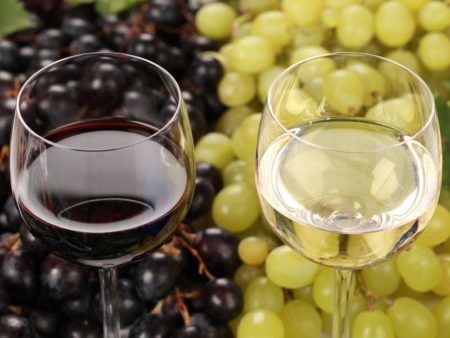 There is no single date from which it is time to harvest. Too many factors affect the maturity and time of harvesting - the characteristics of the variety, climate, sunshine and rainy season, for which harvested grapes will be used. White or black, for dry, table or dessert wines, you need more products or better quality - all this radically changes the date.
There is no single date from which it is time to harvest. Too many factors affect the maturity and time of harvesting - the characteristics of the variety, climate, sunshine and rainy season, for which harvested grapes will be used. White or black, for dry, table or dessert wines, you need more products or better quality - all this radically changes the date.
It is impossible to determine maturity by appearance; even regular sugar tests will not give a complete picture for understanding. If the vineyards have a large area, then sometimes, in order to avoid the risk of losing the entire crop, the harvest starts a little earlier in order to have time to collect all the berries. It is also necessary to take into account the likelihood of rains, which will greatly affect the taste, adding wateriness. Small farms, for which high quality is more important, can withstand the vine longer in order to eventually get a higher sugar content and use it for dessert wines.
For each type of wine product, there are parameters that are determined by the level of sugar content and acidity. For different varieties and regions, their indicators of full maturity:
- for white table wines, sugar should be 16-18%, while the acidity is 7-9%;
- for red table sugar, 17-19% is enough, with an acidity of 7-8%;
- for desserts, the necessary level of 20-22% with an acidity of 6-7% (for such indicators grapes stand on the branches a little longer, waiting for the so-called overripe);
- for the production of champagne take berries collected a little earlier than the technical maturity, so that they do not gain too much sweetness.

Seedless Grapes: Varieties, How to Propagate, Pros and Cons
In a large family of Vinogradovyh plants with seedless berries stand out especially. Gardeners value grape varieties ...
The hotter and drier the climate, the earlier the harvest begins, most often the berries are still slightly immature at this point. In the northern regions, you have to wait a little longer for the fruits to find the necessary sweetness. But do not overexpose too much, otherwise too strong wines with a cloying taste will turn out.
Acidity and sugar content
In addition to sugar, grapes contain many acids, 2 of them, which are the main ones in terms of quantity, are wine and malic.The percentage of their content is important for winemakers, because thanks to variations with an increase or decrease in their number, completely different tastes are obtained, giving a unique charm to certain brands of wine. This is more important for white varieties. On average, indicators should be in the range of 7-10 g / liter, with the exception of special wines. Some winemakers are guided more by the pH level (hydrogen indicator), here the numbers range from 2.7 to 3.7. The pH level indicates the presence of those acids that are not volatile and affect the taste, and the total acidity shows all possible, including those that disappear with time.
Tartaric and malic acids have completely different characteristics, the first is soft, with good taste characteristics, the second is tough, angular, impudent to young drinks. Well-known brands with a high content of malic acid are Pinot noir, Malbec. In winemaking, there is a concept - “fruitful year”, partly it depends on the content of malic acid in the vine in a given season. The cooler the summer, the more it means the quality of the crop will be low and vice versa. In red wines, malic acid is converted to lactic acid, softening the overall taste.
Conclusion
The percentage of sugar and acidity - 2 values, are important in determining the start of harvesting and its further use. Despite the accepted standards for a particular variety, every year they change, depending on the amount of precipitation, the number of sunny days and other conditions. Winemakers decide on the success of the season by analyzing these indicators and comparing them with previous years.




 Non-covering winter-hardy grape varieties for Moscow region
Non-covering winter-hardy grape varieties for Moscow region How to keep the vine in winter
How to keep the vine in winter When can I transfer grapes to another place in the fall
When can I transfer grapes to another place in the fall How to cover and prepare grapes for the winter in the suburbs
How to cover and prepare grapes for the winter in the suburbs